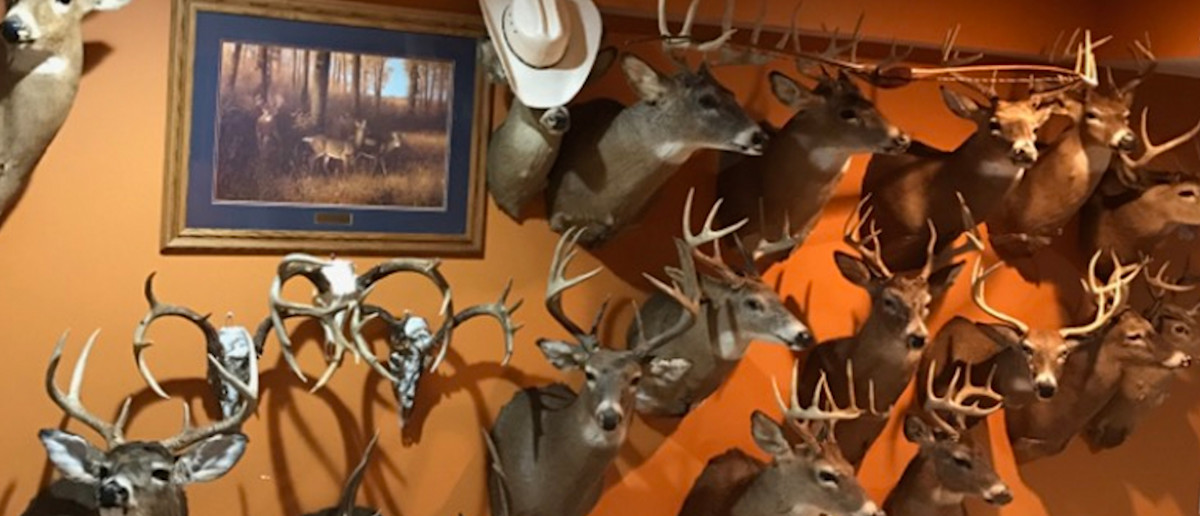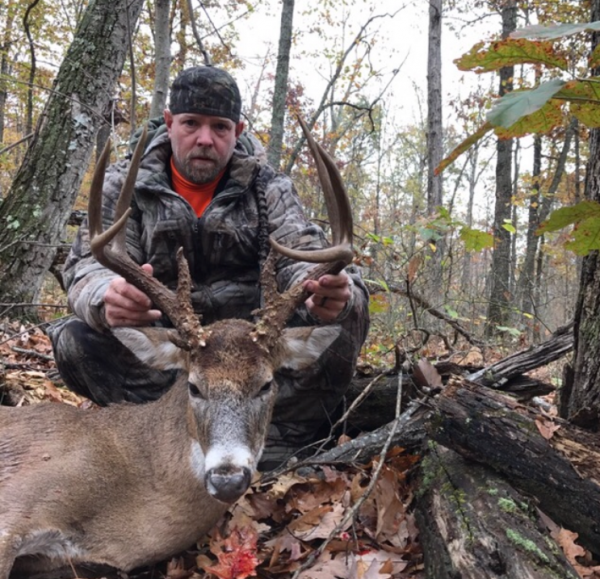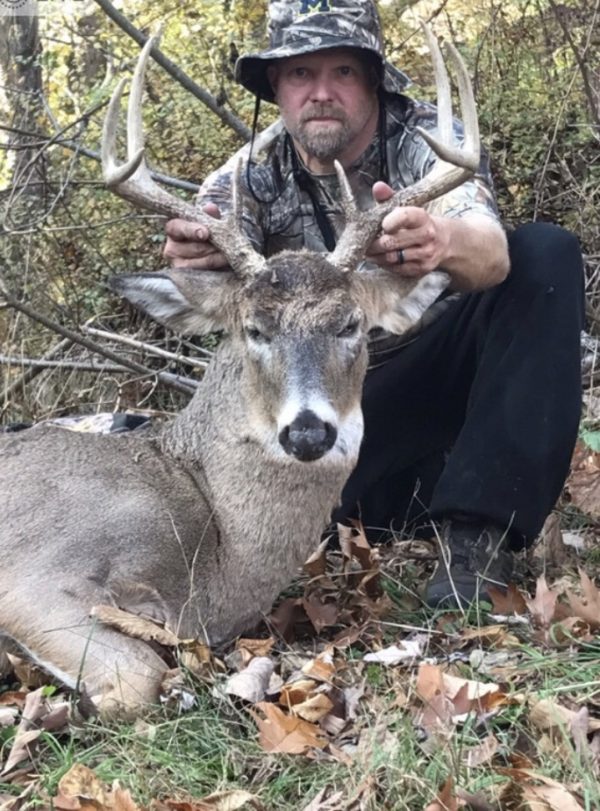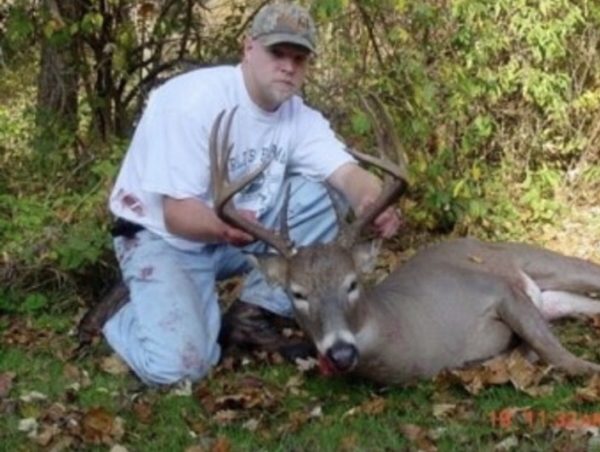
By Andy May
Chad Chrysler is a gritty Michigan hunter who has been consistently killing great bucks for a long time. He’s a very solid hunter who likes to downplay just how good he actually is, and that’s what I love about Chad. He is super humble, but get him talking about deer and you realize just how good he is. Chad has an insatiable urge to keep learning. Even though he knows his hunting areas well enough to be successful for decades to come he continues to pound away, scouting new areas to further his knowledge and to create new adventures. For Chad, It’s not necessarily about the size of the buck’s antlers as it is about the size of the experience and pursuit. He’s open about his mistakes, fun to be around even if the chips are down on a hunt, and just has a never-quit attitude that is contagious. You’ll pick up on all these traits and many more in our Q&A below.
Q: Describe a few of the places that you hunt
A: I started out hunting the big woods of the Northern Lower in Michigan during the late 80’s through the nineties. This area was surely not known for large or older whitetails, but it is where I cut my teeth and learned many of the techniques that I still use today to try and get on the top 10% of the male population. To elaborate, for those that may not understand what is meant by the top 10%, it is simply hunting the top 10% of bucks that the area has to offer. There is no sense in holding out for a four year old P&Y or Booner whitetail if there isn’t one within 10 square miles of the area you are hunting.
I then moved down to Southern Michigan farm land and had very good success in this setting. In my opinion, not having ever hunted prairie land river-bottoms – that I hear are pretty easy to hunt – flat farm land is the least challenging of topography that I have hunted. Not saying it’s easy, but it’s definitely the easiest in my book at least.
I have found a new love over the last several years as well, and that’s hunting public land hill country. Not that I was the last Great White Hunter and poopoo farm land hunting by any means, as I still do my fair share of it, but hunting public land hill county has humbled me as a woodsman and hunter. I’m not the type of hunter that hunts for the kill or the “hey look at me and what I killed.” I hunt for the challenge of the hunt and matching wits with what, in my opinion, is the hardest of the big game creatures to hunt and to be outdoors in what I call my church. Even though I am not an overly religious man, that is what I call it, as I feel at peace.
Q: What has been your most successful hunting tactic?
A: I vary a little here as it depends on many different circumstances, such as weather, time of year, time I have, pressure, etc…
All in all, I am a very aggressive hunter especially on public land. Private, with a limited area to hunt, I am a little more conservative for sure, but I’ll still push the envelope especially early season and during the rut. I’m not a hunter that believes you’ll push a good buck out if you bump him out of his preferred bedroom. He’s chosen that area due to the fact that he feels safe and has good escape routes and has survived many years. He’s not just going to up and find a new bedroom or territory just because you bumped him once or twice. He may be a little more educated, sure, but he could also get a little uncomfortable and make a mistake. I learned this by hunting an 80 acre swamp in Southern Michigan for many years. It was impossible to hunt it without bumping bucks/deer on every entrance and exit when I went afield. It was either do what so many say not to do, or, don’t hunt at all – those were the choices on that particular piece. I hunted this piece heavily for many years and killed some very good bucks by Michigan standards doing so. Now, given the choice, would I have hunted a little differently? Of course, but a lot of times, especially on private land, you don’t have that choice as the most efficient exits and entrances are not available due to lack of access from surrounding properties. This experience did teach me that a lot of what people say about being very cautious is a little over exaggerated, in my personal experience, and in my opinion being overly cautious costs many a hunter an opportunity to kill a good buck or a buck of a lifetime more than anything else.
Like everything else though, it’s a balancing act. I still chose my entrance and exits as carefully as I could and hunted stands in a may to minimize my presence and optimize my chances, but on that particular piece nothing was ever perfect and I was always pushing the envelope while consistently killing good bucks. Moral of the story; it makes no sense in knowing where a good buck or bucks spend their time and not going in to kill them. Way too often I hear of people sitting outside a bucks core area waiting for him to come to you, I firmly believe you have to go to him and kill him on his turf. Remember hunting is a challenge.
I’m huge believer in observations stands as well. I especially like them a few days before the opener or before hunting a new area. Sometimes you can get away with this from the road or a car, but many places I hunt it’s not possible. Setting up in early season a long ways away where there is no chance of you spooking deer can be deadly, as more than likely, come opening morning/evening you can move in on a target buck you spotted and get it done early.
I’ll also use observation stands in new locations I haven’t hunted before in hill country to help me get a feel for how the deer are moving in a certain location. I almost always set up on the top of the ridge with the wind blowing over the other side, never down the ridge. These stands are rarely productive, but it gives me a good feel for if the deer are moving on the top third, middle, or bottom and I move in accordingly. I am by no means an expert when it comes to winds and currents in hill country and I’m always learning and cussing, as it seams to do whatever the hell it wants, but again, I’m aggressive and if I see the deer are moving in a certain area, that is where I’m going to hunt. No sense watching them from afar hoping and praying they come my way. In hill country I’ve found that deer typically will move in one of those quadrants I mentioned above more often than not.
For example, one of my favorite sets in the hills was different year to year. I can’t figure out why, but it just is. One year the deer would seem to prefer the top third, the next they’d be more on the bottom third, then sometimes in the middle of the hill. It still puzzles me to this day, but almost always start high and work your way down. This is on public land, but I would assume the same goes for private. I’m much less concerned with blowing up an area on public, as if I think I’ve over stayed my welcome I’ll quickly move to another area.
Q: What pieces of equipment are key to your hunting style?
A: A good climber is key to me. I’m amazed that people prefer the Summits over the Lone Wolf, but reading a lot of people’s personal opinions it seems to be the case. I guess that goes to show that everybody’s body is different, but for me the Lone Wolf is hands down more comfortable and hunter friendly to my body type and style. It also folds down flat which is key for my mobility.
I found that using a pack frame is an absolute must. I strap my clothes, bow, and stand to a pack frame. It makes those long hikes in to my sets much less strenuous and a hell of a lot more comfortable, saving on time, body wear and exhaustion. If I had to pick one thing that has made my life easier on public land it’d be the pack frame. Takes a little bit getting it setup to your specific equipment, but once you do, I promise you won’t be sorry.
Q: I know you hunt a lot of big woods hill country with fairly high pressure. What can you share in regards to mature bucks using that type of terrain and wind currents?
A: I’ll be honest here I’m terrible with wind and wind currents in hill country. It’s cost me a lot of aggravation and deer. A huge part of the challenge. They seem to have a mind of their own and you could spend a life time learning them and figuring them out, in my opinion, as each nook and cranny seems to act differently.
I’m surely not one that says forget the wind and just hunt, as I think that is truly the most important part of your set up, but a lot of times I will move into a spot and check the wind where I want to hunt and sit there for a bit to get a feel for it. If I don’t like it, I move up or down depending on what it’s doing. Unfortunately, I’ll get up and and it’s different up in the tree. It sucks, but I descend and reset if I don’t like it. Being mobile and able to and willing to adapt is key. Most of my hunts ,when not sitting on a ridge, I’m giving up almost 180 degrees to the wind, sometimes more. Back to part of the challenge.
Deer in hill country are lazy just like any other deer and seem to more often than not take the easy route. I’ll be candid here again, as I really struggle outside the rut getting on true giants in hill country. I think in my last eight years, since I started hunting hill country, I’ve only got on mature deer 6-7 times outside the rut and only killed one. Still learning there, but I’ve been more successful in recent years hunting a little different locations then I do during the rut. I break from the more gradual terrain and pinch point features that I normally hunt during the rut and concentrate on different kinds of cover and even scrapes that I normally detest. What I have found in hill country is that you have to move and move and move again until you find deer. What was great last year, may be a deer desert next year and then good again the following. I’ve found very few spots that are consistent year after year. I equate hill country deer to caribou, you’re either on them or you’re not. You cannot be complacent and must be willing to move until you find them and once you do stay and hone in on them.
Q: You get on more big deer than anyone I know in that particular kind of habitat. What is the key to consistently getting these big buck encounters?
A: The key is to be mobile and willing to keep moving. Hunting heavy pressured hill country is no doubt physically demanding, but it’s much more mentally demanding than anything. It can exhausting and it’s not for everyone, you have to keep it fun. For some of us lunatics it’s an absolute blast, but for others it’s hell. My theory is that if it ain’t fun don’t do it.
Case in point, I have a buddy that is built like Adonis, he played football in college and went on and played some semi-pro, he’s one of the more mentally tough individuals I know, but when it comes to hunting with us in the hill country he acts absolutely miserable and he’s even killed two slammers with us. I’m still not sure why he comes with us as he just doesn’t seem like he’s having fun, although I’m sure the couple bucks he’s killed keeps him going. On the flip side, two of my other hunting partners are built like Rollie Pollies and have never even killed a buck with us, but although they are surely physically and mentally beat down they absolutely love it. Like I said, lunatics
Q: You are very open and honest about your blunders in the woods. Very respectable, in my opinion, and there is so much to learn from these. Can you share your two biggest mistakes that you made and how you learned from them?
A: I have a buddy that swears he’s going to write a book about me and my escapades in the deer woods. I am the king of blunders and missed opportunities. I could write for days on my misadventures; however I’ll save that for another time. I’ve killed a lot of deer in my 42 years on earth and some good ones as well. Every one of them holds a special spot in my mind and heart, but the best memories and stories are always those of the one that got away or how in the world did you mess that up. Those deer and adventures are the ones burned into my memory and as I stated earlier I don’t hunt to kill, I hunt for the adventure, the challenge and the memories.
That is what it’s about for me. None of that “I’ve killed more Booners than you nah, nah, nah…nah, nah”. I’m never too serious in the woods nor do I look at it as a job. If I was or did, I’d quit. This is my leisure time, time that I cherish and I’ll be damned if I’m going to ruin it by crying about what went wrong and what could have been. I will guarantee you that if you hunt with me you will have a good time and laugh. Yes, even at your faults and failures. I always look at the positives and although I’ve let some great deer slip through my fingers, in my mind I’ve won, as I got close enough to that animal to see it or kill it, even if I didn’t seal the deal. The chess match is what I love, not the kill, although I’d be lying if I told you I wouldn’t have wanted those deer on my wall and in my belly.
Q: So many guys hunt in similar areas that you hunt and quit after a few days due to rugged terrain and low deer densities, yet you go back and grind it out every year. Describe your love for the rugged hilly terrain of the Midwest.
A: I’ve eluded to my love of the hill country and why I grind it out, but will rehash:
I’m not exactly sure what it is or why I love the hill country so much, but it boils down to the challenge and what’s around the next corner or more importantly what’s coming around the corner. I’m sure there are much more productive areas to hunt, but coming from flat land Michigan and seeing a 4 year old deer was like sighting a unicorn. I see multiple 4+ year olds every year now. Yes, I’ll go days without seeing any deer, but I’ve seen and have had multiple opportunities at some mega giants and killed a few good deer along the way. Hunting low density deer numbers in foreign terrain has actually humbled me and rekindled my passion for hunting and knowing, however unlikely, that a 200″ deer could step out at anytime keeps me going. Where I’m from and the areas I had to hunt that wasn’t even in my thoughts.
Q: Where do most average hunters fail at pursuing mature bucks in your opinion?
A: Again I alluded to this earlier.
Novice hunters fail for not paying attention to winds, conditions, entrance, exits, stand choices, etc.. I’d say the average to seasoned hunters fail more often by being too cautious. Again if you’re a private land hunter manager, it has it’s place, but even then I see way to many not hunting the deer, but hope the deer somehow will choose to hunt them. Being aggressive is absolutely key! Yes, you’ll screw up some opportunities, but I’ll guarantee you’ll have more opportunities and put some down along the way. There are a ton of great hunters out there and I definitely don’t put myself in the category of some of the greats, but I also know I get on very good deer consistently and it comes down to, that I’m not scared to go where they live.
Q: Do deer calls have their place in your style of hunting?
A: I’m not a call guy and have never had great success with rattling and such. I don’t blind call very often either, but have had good success starting with soft grunts and snort wheezes.
Q: Scent control? How important has it been to your success?
A: My scent control is basically non-existent, I mean I do what I can, but I hike for hours sometimes and what the hell are you going to do with that? The only thing I am particular about is my boots, as they stay sealed with carbon powder and I do my best to avoid touching or rubbing on limbs or vegetation. When you’re in a tree you stink up the down wind side with airborne scent while you are there, when you leave so does your scent. Now walking to and from your stands that scent stays for up to a day or more. That is the scent that concerns me and that I try to keep as minimal as possible.
– Andy May








Conversation